We’ve all dreamed of creating that perfect garden centerpiece that stops visitors in their tracks and becomes the neighborhood’s talking point. Dahlias deliver exactly that wow factor with their spectacular blooms ranging from dinner-plate sized giants to delicate pompoms in every color imaginable.
These stunning flowers aren’t just pretty faces – they’re surprisingly versatile performers that’ll transform any outdoor space into a showstopper. Whether you’re working with a sprawling backyard or a cozy balcony container garden we’ve got creative ideas that’ll maximize your dahlia’s impact.
From dramatic borders that create stunning focal points to mixed plantings that complement other garden favorites we’ll explore design concepts that suit every style and skill level. Ready to discover how these gorgeous blooms can elevate your garden game? Let’s jump into inspiring dahlia garden ideas that’ll have you planning your next planting season before you finish reading.
Choose the Perfect Dahlia Varieties for Your Garden Design
Selecting dahlia varieties that align with your garden’s style creates cohesive outdoor spaces that showcase these magnificent blooms. Different dahlia types offer unique characteristics that complement exact design themes and spatial requirements.
Dinner Plate Dahlias for Bold Statement Pieces
Dinner plate dahlias command attention with their massive 8 to 12 inch blooms that serve as natural focal points in garden beds. We recommend planting varieties like ‘Café au Lait’ with creamy petals or ‘Labyrinth’ featuring deep burgundy colors to anchor large border designs.
Position these giants strategically in back borders where their 4 to 6 foot height won’t overshadow smaller plants. Plant them 3 feet apart to accommodate their substantial spread and prevent overcrowding that limits air circulation.
Support structures become essential for dinner plate varieties since their heavy blooms can snap stems during wind or rain. Install sturdy stakes at planting time to avoid disturbing established root systems later in the growing season.
Pompon Dahlias for Charming Cottage Gardens
Pompon dahlias produce perfectly round 2 inch blooms that fit beautifully into informal cottage garden settings. Varieties such as ‘Franz Kafka’ in purple tones or ‘Sylvia’ displaying bright orange create delightful clusters throughout mixed plantings.
Their compact 2 to 3 foot height makes them ideal for middle border positions where they won’t block views of taller perennials behind them. Space these dahlias 18 inches apart to create full, bushy displays that fill garden gaps effectively.
Combine pompon dahlias with traditional cottage plants like lavender, roses, and delphiniums to achieve that quintessential English garden aesthetic. Their prolific blooming habit provides continuous color from midsummer through first frost.
Cactus Dahlias for Modern Geometric Layouts
Cactus dahlias feature spiky, pointed petals that create striking architectural forms perfect for contemporary garden designs. We suggest varieties like ‘Bishop of Llandaff’ with red blooms and dark foliage or ‘Hawaii’ displaying yellow and red bicolor patterns.
Their unique petal structure adds textural contrast when planted alongside ornamental grasses like fountain grass or feather reed grass. Plant them in geometric patterns or straight lines to emphasize their modern appeal in minimalist garden schemes.
Most cactus varieties reach 3 to 4 feet tall and benefit from 24 inch spacing to showcase their distinctive form without crowding. Their bold silhouettes work exceptionally well as specimen plants in raised beds or large containers.
Create Stunning Color Schemes with Strategic Dahlia Placement
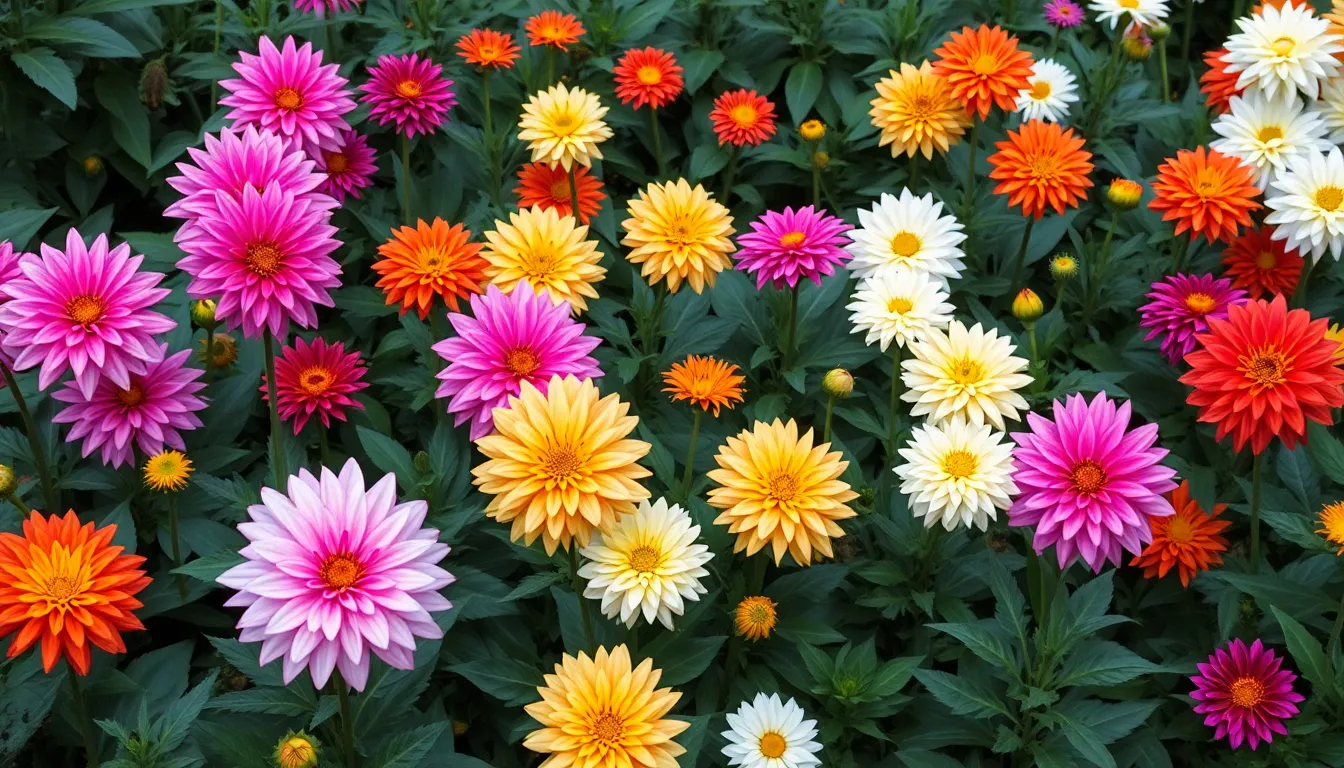
Strategic color planning transforms ordinary dahlia displays into breathtaking garden masterpieces. We’ll explore three proven approaches that create maximum visual impact while showcasing your dahlia varieties’ natural beauty.
Monochromatic Gardens Using Single Color Families
Single color family gardens create sophisticated cohesion that feels both elegant and calming. We recommend selecting dahlias in light, medium, and dark shades of the same color family to build depth and visual interest. Pink dahlia varieties work exceptionally well for this approach, from pale blush dinner plates to deep magenta pompons.
Plant lighter shades in foreground positions where they catch morning sunlight and appear more prominent. Medium tones work perfectly in middle ground plantings, providing transition between light and dark elements. Deep burgundy or wine colored dahlias create dramatic backdrops that make lighter varieties pop forward.
Purple dahlia families offer another stunning monochromatic option, ranging from lavender cactus varieties to rich plum colored blooms. This color family pairs beautifully with silver foliage plants like dusty miller or artemisia for added texture contrast.
Complementary Color Combinations for Visual Impact
Complementary color pairings create dramatic visual effects that make dahlia blooms appear more vibrant and eye catching. Orange and blue combinations work exceptionally well, with bright orange dinner plate dahlias paired against blue delphiniums or salvia companions.
Yellow and purple dahlia combinations deliver bold contrast that commands attention from across the garden. We suggest using bright yellow pompon dahlias with deep purple cactus varieties for maximum impact. This pairing works particularly well in cottage garden settings where bold colors feel natural and welcoming.
Magenta and white combinations offer another striking complementary approach, creating crisp contrast that feels both modern and timeless. White dahlia varieties provide clean backgrounds that make magenta blooms appear more saturated and intense.
Gradient Plantings from Light to Dark Shades
Gradient plantings create beautiful layered effects that guide the eye naturally through your dahlia display. Start with pale colored varieties at one end and gradually transition through medium tones to reach deep, rich colors at the opposite end.
Arrange dahlias in gentle curves or flowing lines rather than rigid rows to create more natural looking gradients. This technique works particularly well with peach to deep coral progressions, or cream to burgundy transitions that span warm color families.
Consider planting gradients in spiral patterns around focal points like garden sculptures or water features. This approach creates ever-changing movement that draws visitors deeper into your garden space while showcasing your dahlia collection’s full color range.
Design Dedicated Dahlia Borders and Bed Layouts
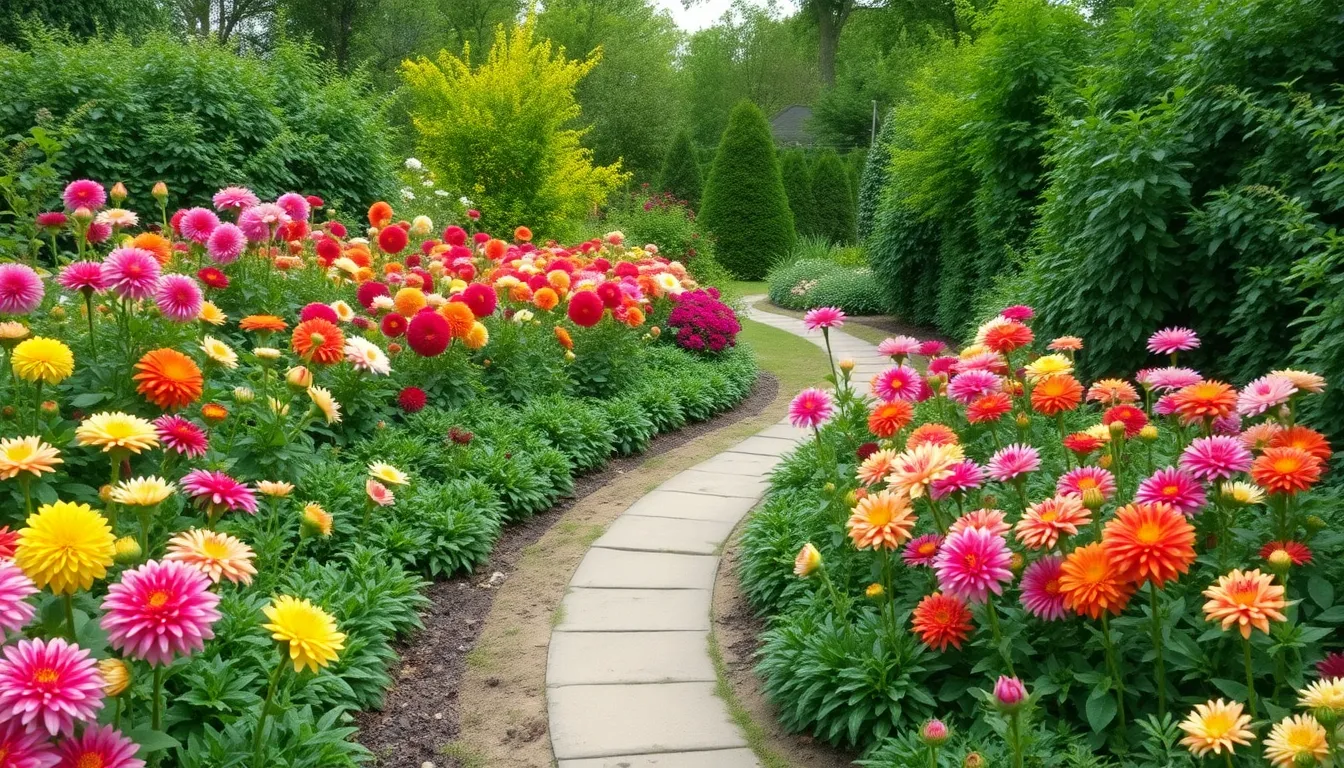
Strategic planning transforms dahlia gardens from simple flower beds into stunning outdoor masterpieces. We’ll help you create purposeful layouts that maximize both visual impact and practical maintenance access.
Linear Border Designs Along Pathways and Fences
Pathway accents create vibrant corridors that guide visitors through your garden space. Plant dahlias along walkways to establish colorful borders that add texture and visual interest to previously plain routes.
Fence integration transforms ordinary barriers into spectacular floral displays by positioning dahlias along the base. This approach maximizes vertical space while creating stunning backdrops that enhance property boundaries.
Height graduation ensures optimal viewing angles by placing shorter dahlia varieties closest to pathways. Taller specimens work best positioned toward fence lines where their impressive blooms won’t obstruct garden views.
Maintenance accessibility becomes effortless when you leave adequate spacing between dahlia plants and pathway edges. We recommend maintaining at least 18 inches of clearance for comfortable walking and plant care.
Circular Island Beds as Garden Focal Points
Central features draw attention to exact garden areas through strategic circular plantings with dahlias as primary attractions. These island beds create natural gathering points that anchor larger industry designs.
Visual contrast emerges when you combine dahlias with complementary plants or low growing shrubs within circular arrangements. This layered approach adds depth and prevents monotonous single species displays.
Size proportions determine the effectiveness of circular dahlia beds in relation to surrounding garden space. Smaller yards benefit from 6 to 8 foot diameter circles while larger properties can accommodate 12 to 15 foot installations.
Access paths should radiate from circular beds to maintain easy plant care without disturbing neighboring flowers. Multiple narrow pathways work better than single wide entrances for preserving bed integrity.
Mixed Perennial Borders with Dahlia Integration
Mixed plantings incorporate dahlias seamlessly into established perennial borders for extended seasonal color. These combinations provide late summer vibrancy when other flowering plants begin their natural decline.
Complementary partnerships pair dahlias with roses, snapdragons, and malope to enhance overall garden color palettes. Such strategic plant selections create harmonious displays that bloom successively throughout growing seasons.
Timing coordination ensures continuous garden interest by selecting dahlia varieties that peak during perennial dormancy periods. This approach eliminates awkward gaps in flowering schedules that can diminish border appeal.
Spacing considerations require careful planning to prevent dahlia tubers from competing with established perennial root systems. We suggest maintaining 24 to 36 inch spacing between dahlias and neighboring perennial crowns.
Build Vertical Interest with Height-Varied Dahlia Arrangements
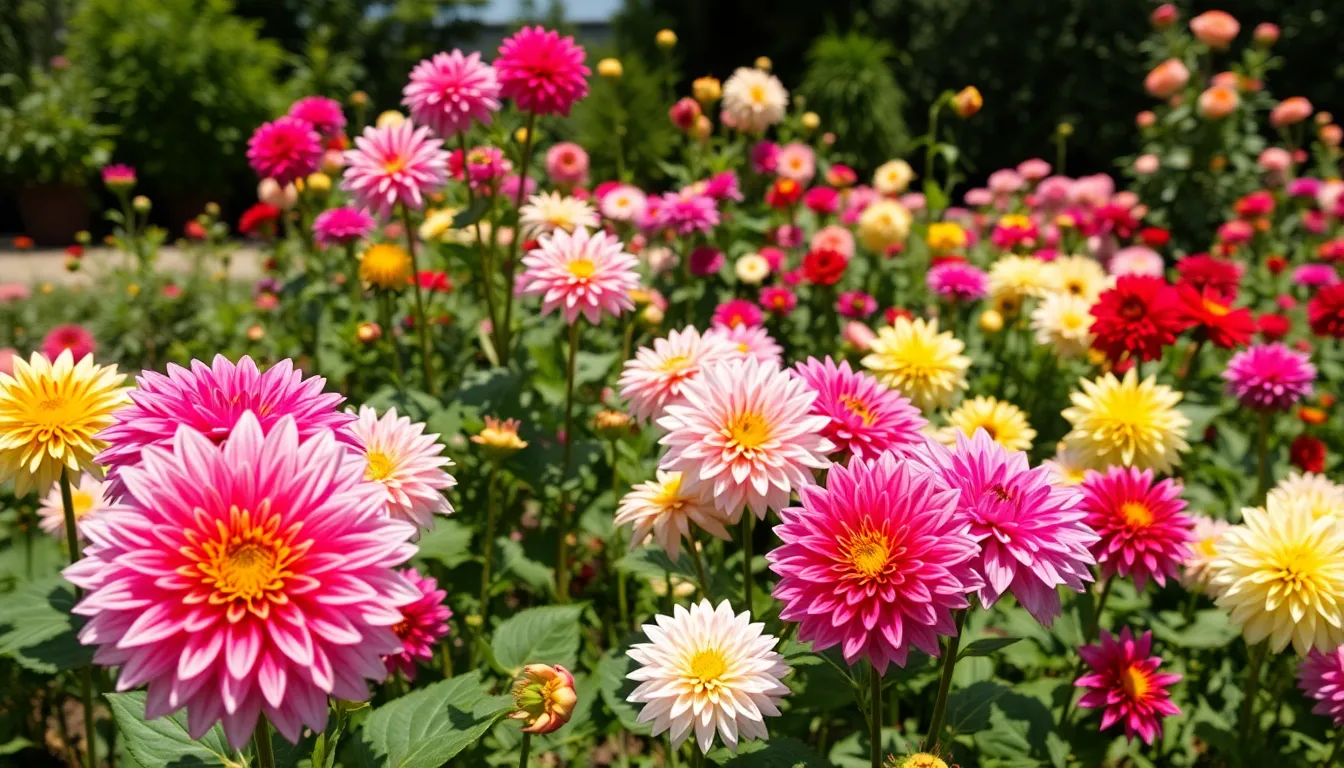
Creating depth and dimension transforms flat dahlia displays into captivating garden features. We’ll explore three proven techniques that maximize visual impact through strategic height placement.
Tiered Planting Systems for Maximum Visual Appeal
Raised beds and terraces create natural elevation changes that showcase each dahlia variety. We construct multiple levels throughout our garden space, with each tier positioned slightly higher than the one in front. Plant taller dahlias at the back of each level while positioning shorter varieties toward the front edge.
Dividing our garden into four flower beds with connecting paths creates an organized tiered system, similar to a 20 m² plot layout. Spacing tubers about 50 cm apart allows us to fit multiple rows per bed without overcrowding. This arrangement ensures every dahlia receives adequate sunlight and air circulation while maintaining the layered visual effect.
Background Tall Varieties with Shorter Front Specimens
Dinnerplate dahlias and Bishop of Dover varieties serve as dramatic backdrops with their impressive height and bold blooms. We position these tall specimens along the rear border where they won’t overshadow smaller plants. Their substantial presence creates a natural wall of color that anchors the entire display.
Gallery series dahlias, growing to approximately 15 inches, work perfectly as front specimens. These compact varieties add vibrant color without blocking the view of taller dahlias behind them. Positioning them strategically creates depth perception that makes our garden appear larger and more professionally designed.
Container Stacking for Multi-Level Displays
Containers of varying sizes stack vertically to create instant height variation in smaller spaces. We arrange larger pots at ground level with progressively smaller containers elevated above them. This technique works especially well for patios, balconies, or areas where permanent raised beds aren’t feasible.
Plant taller dahlia varieties in lower containers while reserving upper pots for shorter cultivars. This inverted arrangement prevents top-heavy displays from becoming unstable while ensuring proper light distribution. Strategic placement of containers at different angles adds visual interest beyond simple stacking patterns.
Incorporate Companion Plants That Enhance Dahlia Beauty
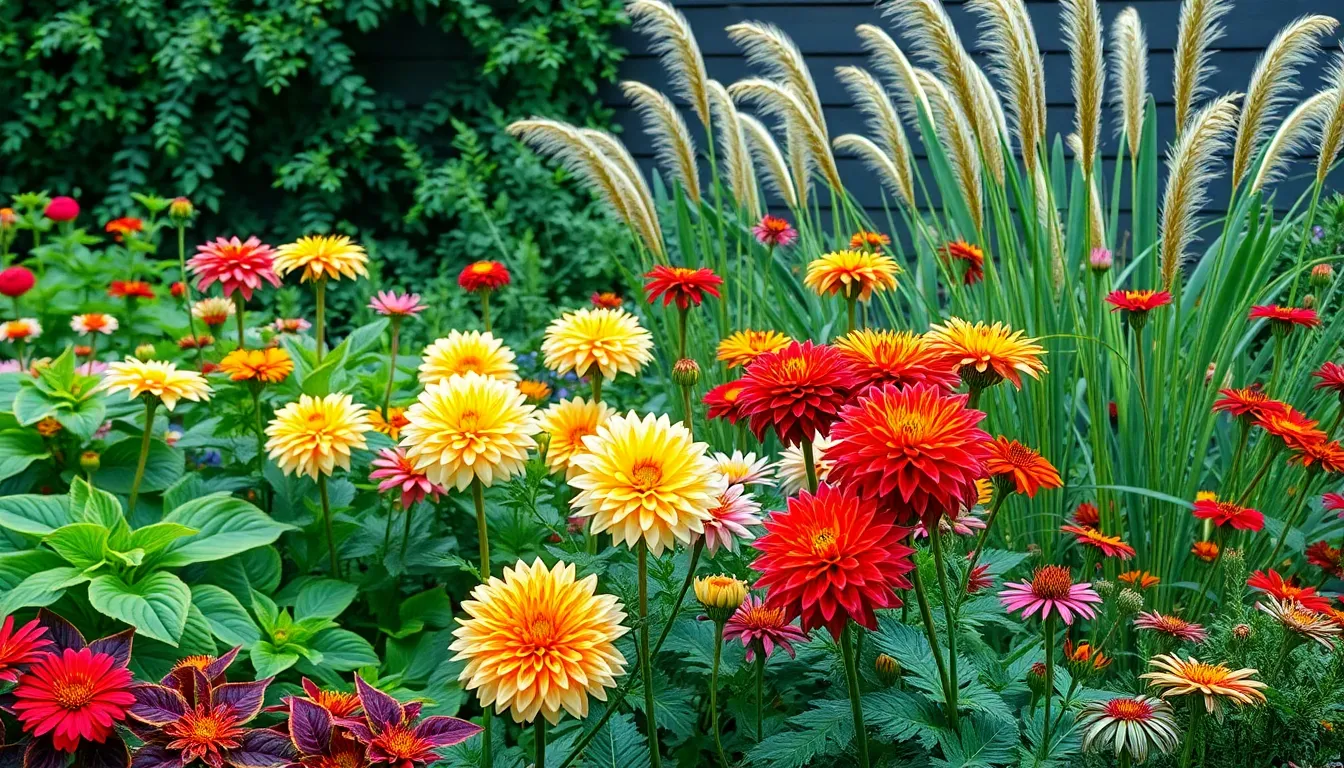
Companion plantings transform ordinary dahlia displays into extraordinary garden masterpieces by adding layers of texture, color, and functionality. We’ve discovered that strategic plant partnerships not only enhance visual appeal but also provide practical benefits like pest control and extended blooming seasons.
Foliage Plants That Complement Dahlia Blooms
Foliage plants create stunning backdrops that make dahlia blooms appear more vibrant and defined. Coleus varieties offer purple, burgundy, and chartreuse leaves that intensify the colors of nearby dahlias, especially pink and coral varieties. Caladium plants provide heart-shaped leaves in striking combinations of white, pink, and green that complement pastel dahlia tones beautifully.
Hostas establish lush green foundations beneath tall dahlia varieties, with their broad leaves creating dramatic contrast against delicate flower petals. We recommend planting variegated hostas like ‘Sum and Substance’ or ‘Patriot’ around dinner plate dahlias for maximum visual impact. Silver-leaved plants such as dusty miller add sophisticated elegance while making bright dahlia colors pop with greater intensity.
Annual Flowers That Bloom Alongside Dahlias
Annual companions extend your garden’s blooming period and create ever-changing color combinations throughout the growing season. Snapdragons provide vertical spikes in complementary colors like purple, pink, and white that blend harmoniously with dahlia arrangements. Cosmos flowers offer delicate, airy textures that soften the bold presence of large dahlia blooms while attracting beneficial pollinators.
Zinnias create vibrant partnerships with dahlias, sharing similar care requirements and blooming periods from summer through frost. We’ve found that compact zinnia varieties work exceptionally well as front-of-border companions to taller dahlia specimens. Marigolds serve dual purposes by contributing warm orange and yellow tones while naturally repelling harmful insects that might damage dahlia plants.
Ornamental Grasses for Texture Contrast
Ornamental grasses introduce movement and architectural elements that enhance dahlia garden sophistication. Fountain grass creates graceful arching forms that provide elegant contrast to the structured roundness of dahlia blooms, with its feathery plumes adding seasonal interest. Pampas grass establishes dramatic height variations when planted behind dahlia borders, creating stunning backdrops for photography and garden viewing.
Feather reed grass offers upright columns that complement the horizontal spread of dahlia plantings without competing for visual attention. We position ornamental grasses strategically to create natural windbreaks that protect delicate dahlia stems while adding textural diversity. Japanese forest grass brings fine-textured foliage in golden or green varieties that illuminates shaded areas around dahlia plantings, creating depth and visual intrigue in garden compositions.
Establish Seasonal Dahlia Garden Themes and Displays
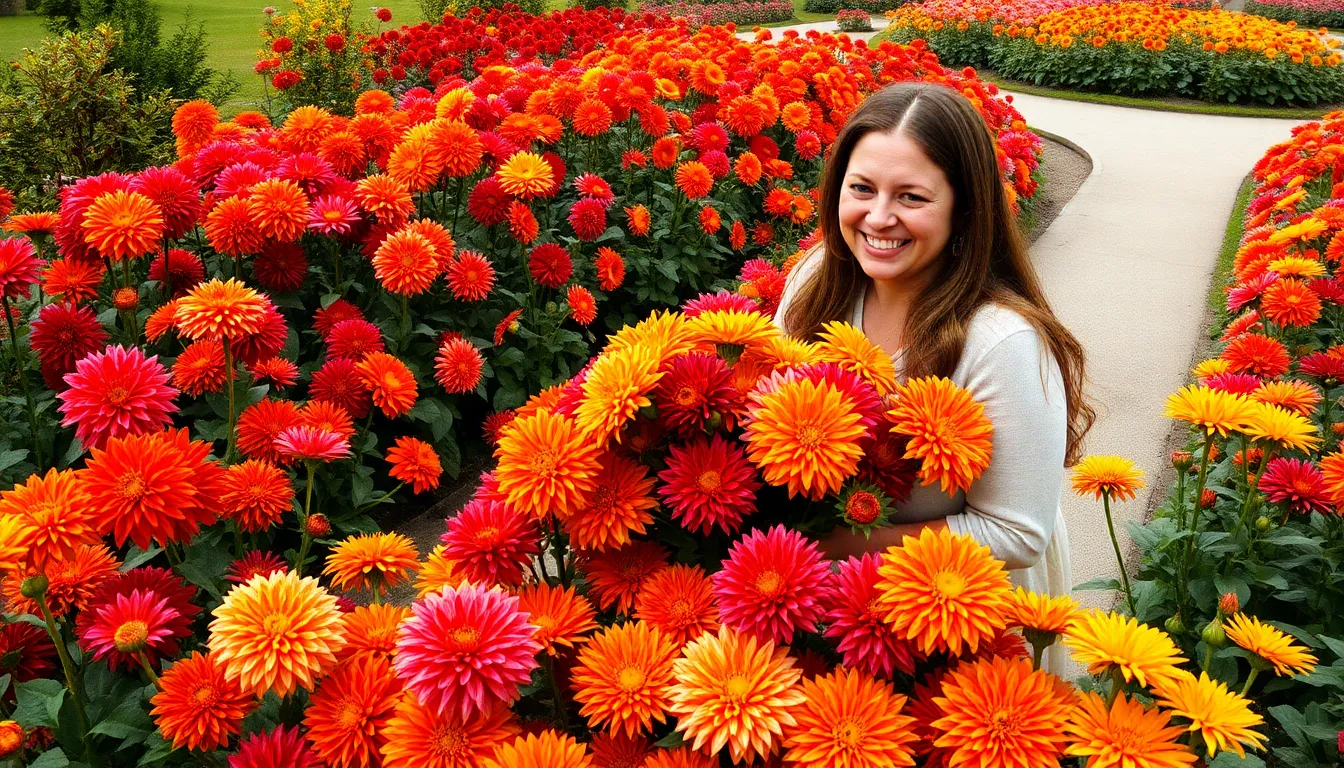
Building on our strategic color and companion planting approaches, we can now create themed dahlia gardens that capture the essence of different seasons while maximizing visual impact throughout the growing period.
Summer Festival Gardens with Bright, Bold Colors
Vibrant dahlias in reds, oranges, pinks, and yellows create the perfect foundation for summer festival themed gardens that evoke celebration and joy. We group our tubers in color-coordinated clusters spaced about 20 inches apart to ensure proper air circulation while maintaining striking visual cohesion. Dividing beds with pathways not only provides easy access for maintenance but also enhances the garden’s overall aesthetic appeal.
Bold color combinations work exceptionally well when we cluster similar hues together rather than mixing them randomly throughout the space. Fiery orange dahlias paired with sunny yellows create an energetic focal point, while hot pink varieties combined with deep reds deliver dramatic summer intensity. These eye-catching displays become perfect centerpieces for summer celebrations and outdoor gatherings.
Planning our layout in advance using a garden notebook helps us map tuber placement strategically for maximum visual impact during peak blooming season. Pathways between beds serve dual purposes by creating natural viewing corridors and providing practical access for watering, deadheading, and harvesting flowers.
Autumn Harvest Themes Using Warm-Toned Varieties
Warm-toned dahlia varieties in deep oranges, rich reds, burgundy, and golden yellow perfectly reflect autumn’s natural color palette while extending our garden’s seasonal interest. These sophisticated hues complement fall foliage and create seamless transitions as summer blooms give way to autumn’s harvest theme. Strategic placement of these warm colors enhances the garden’s ability to mirror nature’s own autumn transformation.
Deep burgundy dahlias serve as anchor points in autumn themed displays, providing rich, saturated color that pairs beautifully with golden varieties. Rich orange selections bridge the gap between summer’s brightness and fall’s deeper tones, while maintaining visual continuity throughout the seasonal transition. Golden yellow dahlias add warmth and light to autumn gardens, preventing the deeper colors from becoming too heavy or overwhelming.
Timing becomes crucial for autumn harvest themes since dahlias continue blooming into the fall months when properly maintained. We can extend the autumn display by selecting varieties known for their late season performance and cold tolerance, ensuring our harvest themed garden remains vibrant well into October.
Cut Flower Gardens for Indoor Arrangements
Dedicated cut flower gardens require exact planning approaches that prioritize stem quality, bloom production, and harvest accessibility over pure ornamental display. We plant dahlias more densely in cutting gardens while still ensuring adequate air circulation and space for proper staking support. Well-amended soil becomes essential for producing the healthy, strong stems needed for long-lasting indoor arrangements.
Dense planting in cutting gardens maximizes our harvest potential while requiring careful attention to spacing for air circulation and disease prevention. Staking becomes even more critical in cutting gardens since we need straight, sturdy stems for professional-looking arrangements. Regular watering schedules help maintain consistent stem quality and bloom production throughout the growing season.
Coordinating flower colors in our cutting garden layout allows us to create harmonious indoor bouquets with strategic planning and advance preparation. We can designate exact sections for different color families, making it easier to gather complementary blooms for arrangements. Various dahlia shapes, sizes, and colors provide incredible versatility for different arrangement styles, from formal displays to casual kitchen bouquets.
Planning our cutting garden with harvest accessibility in mind means creating wider pathways and organizing plants by bloom time and color coordination. This systematic approach ensures we can efficiently gather flowers while maintaining the garden’s productivity throughout the season.
Plan Practical Growing Spaces with Proper Infrastructure

Before planting our first dahlia tuber, we must assess our available space and existing infrastructure to create a foundation for success. Building upon our seasonal displays and cut flower gardens, proper planning ensures we’ll have the practical elements needed to support these stunning blooms throughout their growing season.
Staking and Support Systems for Large Varieties
Large-flowered dahlia varieties require sturdy staking systems to prevent wind and rain damage. Installing stakes at planting time protects our valuable tubers from later root disturbance. We position bamboo, metal, or wooden stakes close to the main stem and tie plants loosely as they develop height and girth.
Grid systems provide extended support in windy locations where single stakes aren’t sufficient. These networks of horizontal wires or netting create a cage-like structure above our dahlia beds. Our dinner plate varieties particularly benefit from this approach since their massive blooms can catch wind like sails.
Timing matters when securing our dahlia supports throughout the growing season. We check ties monthly and adjust them as stems thicken, using soft materials like cloth strips or plant ties to avoid cutting into tender growth. Regular monitoring prevents our prized blooms from snapping under their own weight.
Irrigation Planning for Consistent Moisture
Consistent moisture delivery forms the backbone of healthy dahlia development. We install drip lines or soaker hoses to provide even water distribution while keeping foliage dry and reducing fungal disease risks. Surface watering creates shallow root systems that can’t support our plants during dry spells.
Deep watering schedules encourage robust root development in our dahlia beds. We apply water slowly and thoroughly, allowing moisture to penetrate 6-8 inches into the soil rather than frequent light sprinklings. Our irrigation system should deliver approximately 1 inch of water per week during active growing periods.
Monitoring soil moisture levels helps us adjust watering frequency based on weather patterns. We check moisture depth with a soil probe or our finger, ensuring the root zone stays consistently damp but never waterlogged. During extended dry periods, we increase watering frequency while maintaining our deep application approach.
Storage Answers for Dahlia Tubers
Proper tuber storage over winter determines our next season’s garden success. After the first frost kills our dahlia foliage, we carefully dig up tubers and gently clean off excess soil. Our tubers need several days in a well-ventilated area to dry and cure before long-term storage.
Storage containers filled with appropriate materials protect our dahlia tubers from moisture extremes. We pack dried tubers in boxes with sawdust, vermiculite, or dry peat moss, ensuring each tuber has adequate insulation. Our storage location should maintain cool temperatures around 40-50°F with slight humidity to prevent complete desiccation.
Regular inspection throughout winter storage prevents losses from rot or pest damage. We check our stored tubers monthly, removing any that show signs of decay or insect activity. Maintaining proper storage conditions ensures healthy, viable tubers ready for spring planting in our carefully planned dahlia spaces.
Conclusion
We’ve shared practical strategies to help you create stunning dahlia displays that’ll transform your outdoor space into a vibrant showcase. From selecting the perfect varieties to planning seasonal themes and establishing dedicated cutting gardens these approaches ensure your dahlias reach their full potential.
Remember that successful dahlia gardening combines creative vision with proper infrastructure. With the right staking systems irrigation planning and winter storage techniques you’ll enjoy healthy blooms year after year.
Your dahlia garden can become the crown jewel of your industry whether you’re working with a sprawling backyard or a cozy container setup. Start planning your dahlia paradise today and watch as these magnificent flowers bring color drama and endless joy to your gardening journey.
Frequently Asked Questions
What makes dahlias good centerpiece flowers for gardens?
Dahlias offer impressive blooms and remarkable versatility, making them perfect for various outdoor spaces from large backyards to small balcony containers. Their dramatic flowers create stunning focal points, while their diverse varieties allow for creative design concepts suitable for different gardening styles and skill levels.
What are the main types of dahlias for garden design?
The three main types are Dinner Plate Dahlias with massive blooms that serve as bold statement pieces, Pompon Dahlias featuring compact size perfect for cottage gardens, and Cactus Dahlias with striking architectural forms ideal for modern layouts. Each variety offers unique characteristics for different garden styles.
How do I create effective color schemes with dahlias?
Use three approaches: monochromatic gardens with single color families for elegant cohesion, complementary color combinations like orange-blue or yellow-purple for bold contrasts, and gradient plantings from light to dark shades. These techniques transform ordinary arrangements into breathtaking garden masterpieces.
What seasonal themes work best for dahlia gardens?
Summer festival gardens feature vibrant reds, oranges, pinks, and yellows in color-coordinated clusters. Autumn harvest themes use warm-toned varieties reflecting the season’s natural palette, extending garden interest into fall months while maintaining visual appeal throughout changing seasons.
How do I set up a cut flower dahlia garden?
Focus on dense planting for maximum stem production, install proper staking systems, and organize systematically for efficient harvesting. Plan for easy access between rows and prioritize varieties known for excellent stem quality to ensure continuous supply for indoor arrangements.
What infrastructure do dahlias need for proper growth?
Install staking systems for large varieties to prevent wind and rain damage. Plan irrigation for consistent moisture using deep watering techniques to encourage robust root development. Proper infrastructure ensures healthy plants and protects your investment in dahlia tubers.
How do I store dahlia tubers over winter?
Dig tubers after first frost, clean off soil and debris, then store in cool, dry conditions around 40-50°F. Use peat moss, sawdust, or newspaper for storage medium. Proper winter storage ensures tuber viability for next season’s planting and protects your dahlia investment.







